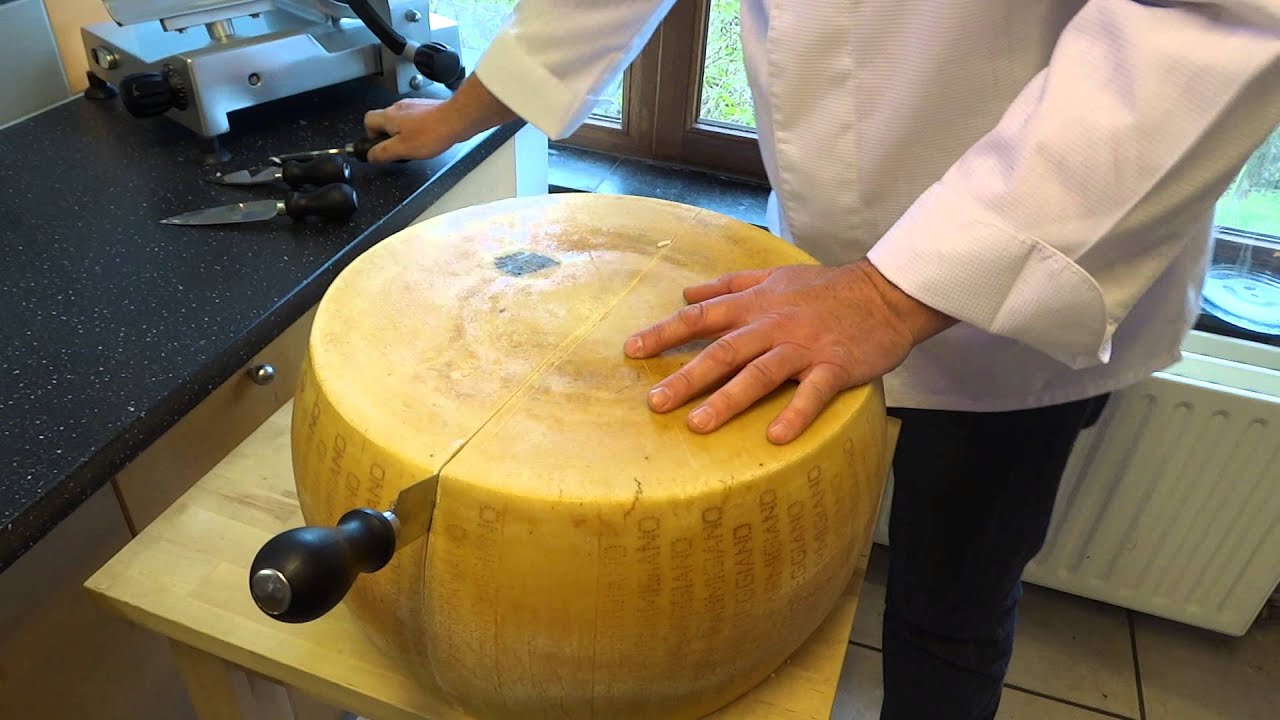Opening a wheel of Parmesan Cheese (Parmigiano Reggiano)
Opening a wheel of Parmesan Cheese
(Parmigiano Reggiano)
*
Parmigiano-Reggiano is made from unpasteurized cow‘s milk. The whole milk of the morning milking is mixed with the naturally skimmed milk of the previous evening’s milking, resulting in a part skim mixture. This mixture is pumped into copper-lined vats.
Starter whey is added, and the temperature is raised to 33–35 °C (91–95 °F). Calf rennetis added, and the mixture is left to curdle for 10–12 minutes. The curd is then broken up mechanically into small pieces. The temperature is then raised to 55 °C (131 °F) with careful control by the cheese-maker. The curd is left to settle for 45–60 minutes. The compacted curd is collected in a piece of muslin before being divided in two and placed in molds. The remaining whey in the vat was traditionally used to feed the pigs from which Prosciutto di Parma (cured Parma ham) was produced. The barns for these animals were usually just a few yards away from the cheese production rooms.

Cracking open a wheel of Parmigiano-Reggiano cheese
The cheese is put into a stainless steel, round form that is pulled tight with a spring-powered buckle so the cheese retains its wheel shape. After a day or two, the buckle is released and a plastic belt imprinted numerous times with the Parmigiano-Reggiano name, the plant’s number, and month and year of production is put around the cheese and the metal form is buckled tight again. The imprints take hold on the rind of the cheese in about a day and the wheel is then put into a brine bath to absorb salt for 20–25 days.
After brining, the wheels are then transferred to the aging rooms in the plant for 12 months. Each cheese is placed on wooden shelves that can be 24 cheeses high by 90 cheeses long or 2160 total wheels per aisle. Each cheese and the shelf underneath it is then cleaned manually or robotically every seven days. The cheese is also turned at this time.
At 12 months the cheese is tested by a master grader who taps each wheel to identify undesirable cracks and voids within the wheel. Wheels that pass the test are then heat branded on the rind with the Consorzio’s logo.
Traditionally, cows have to be fed only on grass or hay, producing grass fed milk. Only natural whey culture is allowed as a starter, together with calf rennet.
The only additive allowed is salt, which the cheese absorbs while being submerged for 20 days in brine tanks saturated to near total salinity with Mediterranean sea salt. The product is aged an average of two years. True Parmigiano-Reggiano cheese has a sharp, complex fruity/nutty taste with a strong savory flavor and a slightly gritty texture. Inferior versions can impart a bitter taste.
*
*
Join Joanne and Frank on Facebook at
Everybody Loves Italian
and
Visit us on the web at dev.everybodylovesitalian.com




